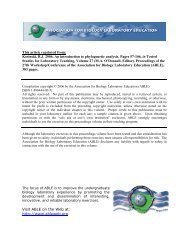Organelle Isolation and Marker Enzyme Assay - Association for ...
Organelle Isolation and Marker Enzyme Assay - Association for ...
Organelle Isolation and Marker Enzyme Assay - Association for ...
You also want an ePaper? Increase the reach of your titles
YUMPU automatically turns print PDFs into web optimized ePapers that Google loves.
138 <strong>Organelle</strong> <strong>Isolation</strong><br />
Table 8.3. Tabulation of results.<br />
Succinate<br />
Acid<br />
Alkaline<br />
dehydrogenase phosphatase<br />
PDE<br />
Fraction A630 f* A410 f A410 f<br />
A<br />
Bp<br />
0 0 0<br />
Bs<br />
Cp<br />
– – –<br />
Cs<br />
Dp<br />
– – –<br />
Ds – – –<br />
* Calculation of f: Calculate the fraction (f) of total activity present in the respective pellets. For<br />
example, <strong>for</strong> tube Bp: fraction (f) = Bp/(Bp + Bs), where Bp is the enzyme activity in the pellet<br />
fraction <strong>and</strong> Bs is the enzyme activity in the supernatant fraction.<br />
Notes <strong>for</strong> the Instructor<br />
This exercise was developed <strong>for</strong> a biology major junior-level undergraduate class. Three<br />
hours time was sufficient when students worked in pairs. It is necessary that the students should<br />
have the outline at least 1 week in advance <strong>and</strong> that they study it be<strong>for</strong>e coming to the laboratory.<br />
The exercise described here could be shortened or elaborated depending on available time <strong>and</strong> need.<br />
For a shorter version, I suggest deleting the second spin (RCF-min of 5 × 10 4 <strong>for</strong> lysosomes) <strong>and</strong> the<br />
assay <strong>for</strong> acid phosphatase. To elaborate the exercise, protein <strong>and</strong> other marker enzymes could be<br />
assayed. In addition, density centrifugation or another suitable step can be added <strong>for</strong> even better<br />
purification of organelles.<br />
This exercise has been developed using an axenic Ax-3 strain of D. discoideum. The same<br />
principle applies when fractionating organelles from other cell-types. However, conditions should<br />
be worked out <strong>for</strong> different cell-types. The clear advantage here is that contractile vacuoles shows<br />
clean separation from mitochondria <strong>and</strong> lysosomes (as shown in Appendix C). Many cells which do<br />
not contain contractile vacuoles will not have such clear separation of organelles. The enzyme<br />
assays described here should work well with other cell-types.<br />
You will need about 10 ml of cell culture per student pair if cells are at 1 × 10 7 /ml. I<br />
homogenize cells in a large volume (up to 20 ml derived from 400 ml culture) <strong>for</strong> an entire class. I<br />
homogenize cells by passing them through polycarbonate filters (see step 2 in the Laboratory<br />
Protocol <strong>and</strong> Appendix B). Other methods of homogenization should also work well. However, it<br />
is important to use Buffer A because alkaline pH <strong>and</strong> a low ionic-strength buffer help dismantle<br />
cytoskeletons <strong>and</strong> there<strong>for</strong>e facilitates homogenization. See Das <strong>and</strong> Henderson (1983) <strong>for</strong><br />
homogenization procedure using polycarbonate filters.<br />
Expected results <strong>and</strong> examples of assignment questions <strong>and</strong> answers are given in Appendix<br />
A. Instructions <strong>for</strong> growing <strong>and</strong> maintaining D. discoideum are given in Appendix B. A table of<br />
the reagents that are required, instructions <strong>for</strong> the preparation of reagents, <strong>and</strong> the instruments,<br />
chemicals, <strong>and</strong> supplies that are required are given in Appendix C.<br />
Additional points to remember include the following:<br />
1. Keep all fractions on ice at all times.
















